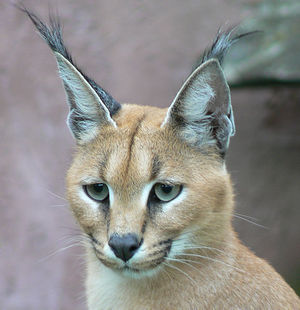Caracal
 From Conservapedia - Reading time: 2 min
From Conservapedia - Reading time: 2 min

The Caracal is a territorial medium-sized cat
- Caracal (Felis caracal)
- Length: 52"
- Weight: 60 pounds
- Height: 20 inches
- Gestation: 70 to 78 days
- Litter Size: 1 to 4 cubs
- Life span: About 15 years
Contents
Physical Characteristics[edit]
The caracal resembles the lynx and often called the "desert lynx". The caracal is smaller than the lynx, weighing about fifty pounds; males are notably larger than the females. The fur of the caracal is a reddish-brown color with white on their chin, throat, and belly. The caracal has a large, slender body. Its hind legs are longer than its forelegs. The tufts on its large ears are the longest of all the felines. The meaning of caracal is "black-ear".
Habitat and Daily Life[edit]
The caracal is found in most of Africa and parts of Central India in mostly dry areas, but also woodlands, savanna, hilly areas, and scrubland. They are solitary, nocturnal animals and only socialize to mate. The caracal is an excellent climber, and sometimes will bring its prey up a tree to avoid loosing it to other meat eaters. It is the fastest cat of its size.
Hunting and Feeding[edit]
The caracal preys upon rodents, hedgehogs, baby impala and other smaller antelope. The caracal attacks with a bite at the throat. The bite will snap small animals necks and suffocate larger animals such as antelope.
Reproduction[edit]
Copulation takes place over a period of six days. After seventy to seventy-eight days one to four cubs will be born blind and helpless. After one week they will open their eyes; after nine to ten days they will walk for the first time. After forty-five days they being to eat meat; after four to six months they are fully weaned. The cubs will stay with the mother for about a year, then they will develop a territory of their own. Male territories are larger than that of the female. One male territory may over lap several female territories. The male will mate with the caracals in its territory.
Status[edit]
The caracal population is relatively stable except for some Asian subspecies. In India the caracal is profiting from the tiger conservations. It takes twenty caracal skins to make one coat, but they are not of high value, so trading is not very common. The future of the caracal looks optimistic.
 KSF
KSF